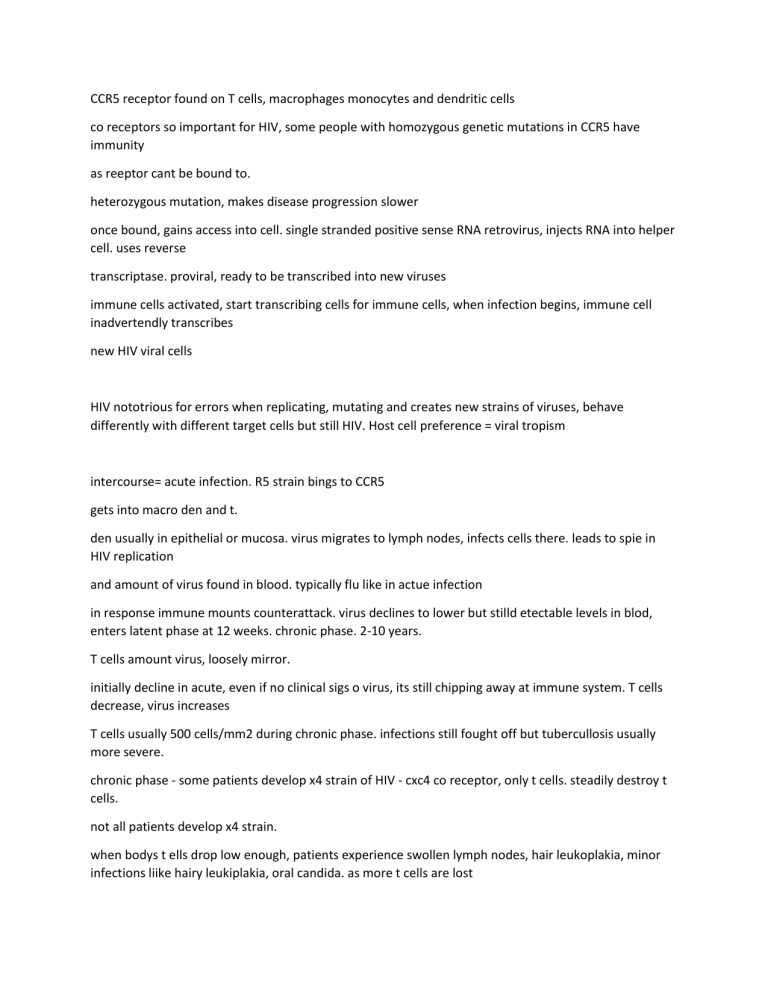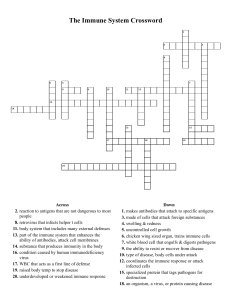
CCR5 receptor found on T cells, macrophages monocytes and dendritic cells co receptors so important for HIV, some people with homozygous genetic mutations in CCR5 have immunity as reeptor cant be bound to. heterozygous mutation, makes disease progression slower once bound, gains access into cell. single stranded positive sense RNA retrovirus, injects RNA into helper cell. uses reverse transcriptase. proviral, ready to be transcribed into new viruses immune cells activated, start transcribing cells for immune cells, when infection begins, immune cell inadvertendly transcribes new HIV viral cells HIV nototrious for errors when replicating, mutating and creates new strains of viruses, behave differently with different target cells but still HIV. Host cell preference = viral tropism intercourse= acute infection. R5 strain bings to CCR5 gets into macro den and t. den usually in epithelial or mucosa. virus migrates to lymph nodes, infects cells there. leads to spie in HIV replication and amount of virus found in blood. typically flu like in actue infection in response immune mounts counterattack. virus declines to lower but stilld etectable levels in blod, enters latent phase at 12 weeks. chronic phase. 2-10 years. T cells amount virus, loosely mirror. initially decline in acute, even if no clinical sigs o virus, its still chipping away at immune system. T cells decrease, virus increases T cells usually 500 cells/mm2 during chronic phase. infections still fought off but tubercullosis usually more severe. chronic phase - some patients develop x4 strain of HIV - cxc4 co receptor, only t cells. steadily destroy t cells. not all patients develop x4 strain. when bodys t ells drop low enough, patients experience swollen lymph nodes, hair leukoplakia, minor infections liike hairy leukiplakia, oral candida. as more t cells are lost immune system severely compromised, progress to AIDS persistent feverm weight losss diarrhea certsin conditions develop ; aids defining. pneumonia, candiasis of oesophagus, tumours and kaposis sarcoma, primary lymphoma of brain many die of infections that otehrs can dfend off male to male most common transmission in US male to female in less resourced areas female to male HIV present in vafinal and cervical fluids 75% throughs exual inercouse intravenous mother to child through placenta delivery breast milk blood transfusions diag antibody test looks for antibodies against HIV that the body has made antigen/antibody tests look for virus itself as well as the antibody the body has made RNA/DNA tests - screen for viral RNA, detect directly. DNA tests look for copies of the virus screening, recomended antibody/antigen test, better at identifying arlier infection. confirm Luts Gurtler: detecting antibodies specific to viorus, or detecting virus. p24 antigen, nucleaic acid based test or culture and virus isolation. 40-60% homology between genes in HIV-1 and HIV-2. antibodies begin to be detectable 6-8 weeks after infection. diagnostic window/serological latency. may be shorter than 6 weeks may be several weeks longer but inability to detect antibodies 3 months aftre infection is unsual antibodies persist for life. antibodies to the integrase detected after antibodies to reverse transcriptase and other viral proteins appear screening assays - Enzyme linked immunosorbent assays (ELISA) commonly used alongside agglutination. sensitivity increased by using recombinant proteins and peptides in assays. double antigen assays more senstiive in early phase of seroconversion. low crossreactvity with other subtypes, subtypes other than B might be missed during early seroconversion


